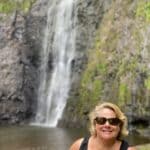A Trip to the Galapagos Islands Aboard the MV Santa Cruz
Seniors take note: If you have not been to the Galapagos and are contemplating a visit, you need to be aware of the potential challenges involved. As a 70 year old, and not a particularly fit person, the Galapagos trip was a challenge.
I experienced it for 5 days onboard the MV Santa Cruz, a 98-passenger vessel, one of the larger ships operating in the area.
Just transferring from the dock to the ship in zodiacs or “pangas” can be a challenge – as well as an adventure. Walking down a wet, slippery staircase or dock, stepping from there onto the bouncing zodiac side wall, and then onto the step they thankfully place in the bottom of the zodiac, to step down to the unstable floor is already a challenge for some.
You sit on the side walls of the zodiac for all transfers between the ship and the islands you visit, and have to carefully balance the weight on each side by only one person moving at a time entering or exiting the craft on alternating sides.
Once out to the ship, you ascend the wet metal staircase, over the 10 inch high transom into the lobby area.
Additional public rooms onboard are the main bar, a meeting room/departure lounge cum everything, and the dining room with padded booths and comfy padded barrel chairs and tables.
The dining room seats the full complement of guests and staff simultaneously. Breakfast and lunch are generally buffet style, with the dinner menu presented at breakfast so the chef knows what to prepare for the evening.
Everyone gets the first course, usually a salad dish, or it might be prosciutto or maybe fish, and a choice of soup or pasta as a second course, followed by the main entrée selected earlier, and dessert. The meals reflect the Ecuadorian cuisine as well as international dishes. They are well prepared and presented, and were visually pleasing and tasty.
You will experience two types of landing on the various islands you visit: “wet” and “dry.”
Most landing are wet: to disembark from the zodiac, you slide to the bow, one at a time, alternating sides, swing your legs over the side and drop off into the water, which hopefully is only to your knees – more or less, and walk up the very sandy beach, among the sea lions, and don your walking shoes.
Make sure you have really good soles and grips, because the islands are all volcanic, and there can be quite a bit of walking on the lava rock. In some cases you will be walking from one rock to another, hoping it stays stable enough to shift your weight on to the next one.
There are few flat surfaces, no benches for resting, and no option of leaving the park ranger, who is, unfortunately, about 50 years your junior and in really fit condition!
The trek is usually between 2-3 miles and varies between uphill and downhill walking, often leaving you panting for breath in the heat. When the guide pauses for a talk, you get to take pictures, catch your breath, and start plotting your next footsteps.
You will, however, see the most unique creatures. Of the many types of land iguanas- most endemic to their own island only, we saw 1) the Santa Fe Iguana- about the size of a collie only much lower to the ground and pale yellow all over; 2) South Plaza Island Iguanas, pale yellow heads and light grey bodies; 3) Punta Pitt area brought us the San Cruz ones , which are grey all over.
Marine Iguanas are prevalent on all the islands, but vary from all black to a red/yellow/black variety on Espanola. Lava Lizards abound on all the islands. They vary slightly in coloration but have a rickrack type of pattern on their backs. The islands have some snakes, but very reclusive and small.
The birds really own the Galapagos islands. Red Footed Boobies, Blue Footed Boobies and Nazca Boobies, Tropicbirds, Frigates- common and magnificent, Lava Gulls, Kelp Gull, Brown Pelicans, Vermilion Flycatcher, Large, Medium and Small Ground finches plus Darwins finch, Large Cactus Finch, Galapagos Dove, San Cristobal Mockingbird, Petrels, Waved Albatross, Cattle Egrets and Swallow Tailed Gulls round out the list for this trip. Some in our group saw flamingos. Giant Tortoises are now only present on islands prohibited from visitation or on San Cristobal at the Darwin Research Center. You may no longer walk among them.
Each day you are presented with one island in the morning, with its 2-3 mile hike and again another island in the afternoon with its 2-3 mile hike. They provide snorkeling opportunities off the boat or from a glass-bottom boat, where you can snorkel with sea lions or, if you are lucky, see native penguins swimming below the surface.
A Galapagos vacation is definitely a unique experience and certainly an adventure, but may not be as leisurely a trip as some travelers may be anticipating.
To learn more about adventure vacations to the Galapagos Islands including a nature cruise aboard the MV Santa Cruz Ship, contact Nancy Bandley.



